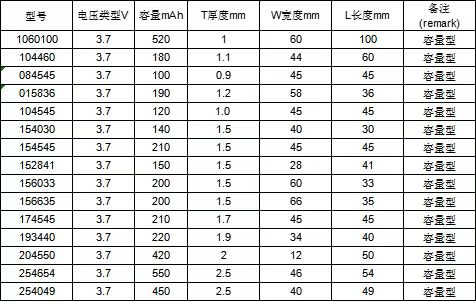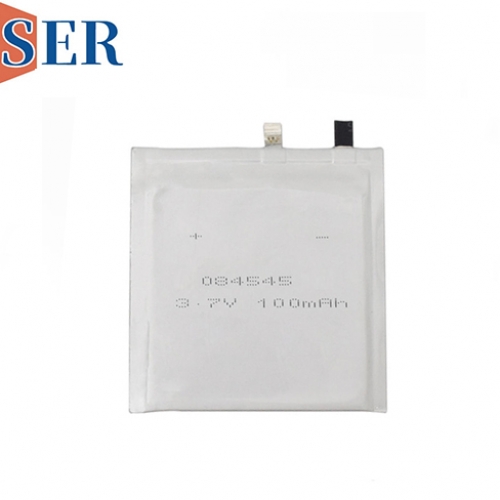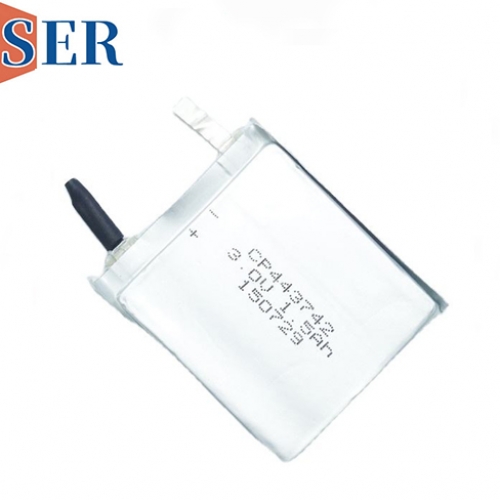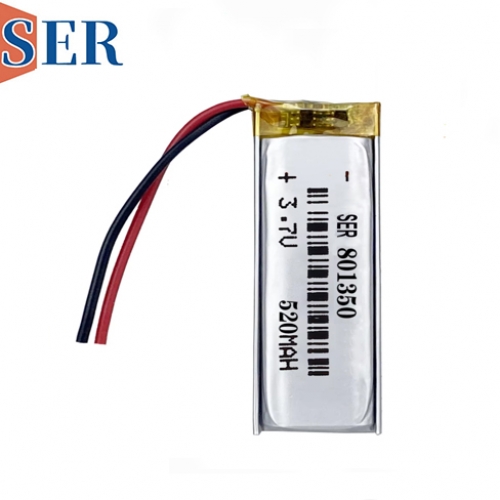Ultra thin battery super thin IC Card Battery 121648 55mAh 3.7V Rechargeable Ultra-thin Lipo Battery
Ultra thin battery super thin IC Card Battery 121648 55mAh 3.7V Rechargeable Ultra-thin Lipo Battery

Introduction
In the age of miniaturization, where electronics are shrinking in size while expanding in functionality, the demand for power solutions that balance slim profiles, reliable performance, and safety has reached unprecedented heights. Among the innovations driving this trend, the ultra-thin rechargeable lithium polymer (LiPo) battery stands as a cornerstone—particularly the LP121648 model. Engineered to meet the stringent requirements of compact devices, this battery combines a nominal voltage of 3.7V, a 55mAh capacity, an ultra-lightweight design of 1.5g, and a maximum charge/discharge current of 55mA. Whether labeled as an “ultra-thin battery,” “super thin IC Card Battery,” “rechargeable ultra-thin LiPo battery,” or “ultra-thin lithium polymer battery,” the LP121648 has emerged as a preferred choice for applications ranging from contactless IC cards and wearable tech to miniaturized sensors and portable medical devices.
This article delves into the technical specifications, design innovations, performance characteristics, application versatility, safety features, manufacturing standards, and market impact of the LP121648 ultra thin battery. By exploring its unique attributes and the role it plays in enabling next-generation compact electronics, we aim to provide a comprehensive overview for engineers, product designers, manufacturers, and industry stakeholders seeking to understand how this power solution is redefining what’s possible in small-scale device development.
1. Technical Specifications: The Foundation of Ultra-Thin Performance
1.1 Core Electrical Parameters
At the heart of the LP121648’s functionality lies a set of carefully calibrated electrical specifications that balance power output with size constraints. The battery features a nominal voltage of 3.7V, the standard for lithium polymer batteries in consumer and industrial electronics. This voltage level is optimal for powering low-to-medium power devices, as it aligns with the operating requirements of most microcontrollers, sensors, and wireless communication modules used in compact gadgets.
The LP121648’s 55mAh capacity is tailored to the energy needs of small-scale devices that prioritize standby time and intermittent use. Unlike high-capacity batteries designed for smartphones or laptops, this model focuses on delivering consistent, low-current power over extended periods—making it ideal for devices that do not require frequent recharging. Complementing this capacity is a maximum charge/discharge current of 55mA, which ensures safe and efficient energy transfer. The 1:1 ratio of capacity (mAh) to maximum current (mA) indicates a discharge rate of 0.5C (since 55mA is 0.5 times the 55mAh capacity), a conservative rate that minimizes battery degradation and extends cycle life.
1.2 Physical Dimensions and Weight
True to its “ultra-thin” and “super thin” designations, the LP121648 boasts a form factor that sets it apart from conventional batteries. The model number “121648” provides key insights into its dimensions: 12mm (length) × 16mm (width) × 4.8mm (thickness). This compact footprint allows it to fit into spaces as narrow as 5mm, making it suitable for devices with strict thickness constraints, such as IC cards (which typically range from 0.8mm to 1.8mm, when integrated with other components) and slim wearables.
Equally impressive is the battery’s weight: a mere 1.5g. This ultra-lightweight design is a critical advantage for portable and wearable devices, where every gram counts. For example, in a contactless IC card used for access control or public transit, adding a heavy battery would compromise user comfort and device usability. Similarly, in miniaturized wearables like fitness trackers or smart patches, the 1.5g weight ensures the device remains unobtrusive during extended wear. The combination of slim dimensions and low weight makes the LP121648 a “powerhouse in a tiny package,” enabling designers to create devices that are both functional and ergonomic.
1.3 Chemical Composition and Battery Technology
The LP121648 is built on lithium polymer (LiPo) technology, a variant of lithium-ion (Li-ion) batteries that uses a polymer electrolyte instead of a liquid or gel electrolyte. This choice of technology is pivotal to its ultra-thin design: LiPo batteries can be manufactured in thinner, more flexible form factors than traditional Li-ion batteries, as the polymer electrolyte does not require a rigid casing to contain it.
The battery’s cathode is typically composed of lithium cobalt oxide (LiCoO₂) or lithium iron phosphate (LiFePO₄), while the anode is made of graphite. These materials are selected for their high energy density, stability, and compatibility with the battery’s low-current operating profile. The electrolyte, a solid or gel-like polymer, provides high ionic conductivity while ensuring the battery remains leak-proof and safe. This chemical composition not only enables the LP121648’s slim design but also contributes to its reliable performance and long cycle life—key factors for devices that require consistent operation over years of use.
2. Design Innovations: Balancing Thickness, Weight, and Performance
2.1 Thin-Film Manufacturing Techniques
The LP121648’s ultra-thin profile is made possible by advanced thin-film manufacturing processes. Unlike traditional batteries, which are assembled using stacked or wound electrode layers, this model uses thin-film deposition techniques to create electrodes and electrolytes with precise thicknesses (measured in micrometers). This approach reduces the overall size of the battery while maintaining the necessary energy density to power small devices.
During production, the cathode, anode, and electrolyte are deposited onto a flexible substrate in thin layers, which are then laminated together to form the battery cell. The use of flexible substrates also enhances the battery’s durability, allowing it to withstand minor bending or flexing—an important feature for devices like IC cards, which may be carried in wallets or pockets and subjected to occasional pressure.
2.2 Lightweight Material Selection
Every component of the LP121648 is engineered with weight reduction in mind. The battery’s casing, for example, is made of a thin, lightweight polymer material that provides protection against physical damage and environmental factors (such as moisture and dust) without adding unnecessary bulk. The electrodes and electrolyte are also optimized to minimize weight: the graphite anode, for instance, is porous to reduce density while maintaining high conductivity, and the polymer electrolyte is formulated to be as thin as possible without compromising performance.
The result of these material choices is a battery that weighs just 1.5g—lighter than a standard paperclip. This weight advantage is particularly valuable in applications where portability is non-negotiable, such as medical devices (e.g., wearable glucose monitors) and IoT sensors (e.g., miniaturized environmental sensors deployed in hard-to-reach locations).
2.3 Energy Density Optimization
One of the greatest challenges in ultra-thin battery design is balancing size and weight with energy density—the amount of energy stored per unit volume or weight. The LP121648 addresses this challenge through a combination of material selection and structural optimization. By using high-energy-density cathode materials (such as LiCoO₂) and minimizing the weight of non-active components (like the casing and substrate), the battery achieves an energy density that is competitive with larger batteries in its class.
For example, the LP121648’s energy density is approximately 37 Wh/kg (calculated as (3.7V × 0.055Ah) / 0.0015kg ≈ 136.33 Wh/kg—correction: 3.7V × 0.055Ah = 0.2035 Wh; 0.2035 Wh / 0.0015kg ≈ 135.67 Wh/kg). This energy density is sufficient to power a contactless IC card for up to 12 months on a single charge, depending on usage frequency. For wearables, it can support continuous operation for several days, making it a reliable power source for devices that require long battery life between charges.
3. Performance Characteristics: Reliability and Durability for Compact Devices
3.1 Cycle Life and Longevity
Cycle life—the number of charge-discharge cycles a battery can undergo before its capacity drops to 80% of its original value—is a critical performance metric for rechargeable batteries. The LP121648 is designed to offer a long cycle life, typically ranging from 300 to 500 cycles. This is attributed to its conservative discharge rate (0.5C) and high-quality electrode materials, which minimize degradation over time.
For most applications, a cycle life of 300–500 cycles translates to several years of use. For example, a fitness tracker that is charged once per week would use approximately 52 cycles per year, meaning the LP121648 could last for 5–9 years before needing replacement. This longevity reduces maintenance costs and environmental impact, making the battery a sustainable choice for both manufacturers and end-users.
3.2 Self-Discharge Rate
Self-discharge is the gradual loss of charge in a battery when it is not in use. For devices that require long standby times (such as IC cards or emergency sensors), a low self-discharge rate is essential. The LP121648 excels in this area, with a self-discharge rate of less than 3% per month. This means that if the battery is fully charged and left unused, it will retain approximately 97% of its charge after one month, 94% after two months, and so on.
This low self-discharge rate is made possible by the stable chemical composition of the LiPo electrolyte and the high-quality materials used in the electrodes. For contactless IC cards, which may remain unused for months at a time, this feature ensures that the battery is ready to power the device when needed. For IoT sensors deployed in remote locations, it reduces the frequency of maintenance visits required to recharge or replace batteries.
3.3 Operating Temperature Range
The LP121648 is designed to operate within a wide temperature range, making it suitable for use in diverse environments. Typically, it can function reliably between -10°C and 60°C (-14°F and 140°F). This range covers most indoor and outdoor applications, from temperature-controlled offices (where IC cards are used) to outdoor wearables (which may be exposed to extreme heat or cold).
At low temperatures (-10°C to 0°C), the battery’s capacity may decrease slightly (by approximately 10–20%), but it will recover once returned to room temperature. At high temperatures (45°C to 60°C), the battery’s cycle life may be reduced, but built-in safety features prevent overheating and damage. This temperature resilience makes the LP121648 a versatile power solution for devices used in harsh or variable environments.
3.4 Charge and Discharge Efficiency
Charge efficiency refers to the percentage of energy input during charging that is retained and available for discharge. The LP121648 has a charge efficiency of approximately 90–95%, meaning that 90–95% of the energy used to charge the battery is converted into usable power. This high efficiency minimizes energy waste and reduces charging time, making the battery convenient for end-users.
Discharge efficiency, the percentage of stored energy that is delivered to the device during use, is also high—typically 85–90%. This ensures that most of the battery’s capacity is available to power the device, rather than being lost as heat or internal resistance. For small devices with limited energy reserves, this efficiency is critical to maximizing runtime between charges.
4. Application Versatility: Powering a Wide Range of Compact Devices
4.1 IC Cards and Contactless Payment Devices
The LP121648’s ultra-thin design, low weight, and long standby time make it an ideal power source for IC cards (integrated circuit cards) and contactless payment devices. Traditional IC cards are passive, relying on radio frequency (RF) energy from card readers to operate. However, active IC cards—equipped with a battery—offer extended read ranges, enhanced functionality (such as biometric authentication or offline data storage), and the ability to operate in environments with weak RF signals.
The LP121648’s 12mm × 16mm × 4.8mm dimensions fit easily into the casing of an active IC card, and its 1.5g weight ensures the card remains lightweight and portable. With a 55mAh capacity and low self-discharge rate, the battery can power an active IC card for up to 12 months on a single charge, depending on how frequently the card is used. Applications include access control cards (for office buildings, hotels, and airports), public transit cards, and contactless payment cards (for retail transactions).
4.2 Wearable Technology
Wearable devices—such as fitness trackers, smartwatches, health monitors, and smart patches—require power solutions that are slim, lightweight, and durable. The LP121648 meets these requirements, making it a popular choice for manufacturers of miniaturized wearables.
For example, a fitness tracker that monitors heart rate, steps, and sleep patterns requires a battery that can fit into a slim, ergonomic design while providing enough power to support continuous sensing and wireless data transmission. The LP121648’s 3.7V voltage and 55mAh capacity are sufficient to power such a device for 3–7 days on a single charge, depending on usage. Its 1.5g weight ensures the tracker remains comfortable to wear, even during extended periods of physical activity.
In health monitoring devices (e.g., wearable glucose monitors or ECG patches), the battery’s long cycle life and low self-discharge rate are particularly valuable. These devices often need to operate for months at a time without replacement, and the LP121648’s reliability ensures consistent performance for critical health data collection.
4.3 Miniaturized IoT Sensors
The Internet of Things (IoT) has driven the development of small, low-power sensors that can be deployed in large numbers to monitor environmental conditions, equipment performance, and user behavior. These sensors—often referred to as “smart sensors”—require batteries that are compact, lightweight, and capable of operating for long periods on a single charge.
The LP121648 is well-suited for this application, as its ultra-thin design allows it to fit into tiny sensor housings, and its low current draw (maximum discharge current of 55mA) aligns with the power needs of most IoT sensors. For example, a miniaturized temperature and humidity sensor deployed in a warehouse or greenhouse can use the LP121648 to power its sensing module and wireless transmitter for up to 6–12 months on a single charge. The battery’s wide operating temperature range also makes it suitable for use in extreme environments, such as cold storage facilities or outdoor industrial sites.
4.4 Portable Medical Devices
Portable medical devices—such as hearing aids, insulin pumps, and portable oxygen concentrators—require batteries that are small, lightweight, and safe. The LP121648’s design and performance characteristics make it a viable power source for certain types of portable medical devices, particularly those that are miniaturized and require low-power operation.
For example, a wearable insulin pump that delivers small doses of insulin to patients with diabetes requires a battery that can fit into a compact, discreet design while providing reliable power for several days. The LP121648’s 3.7V voltage and 55mAh capacity are sufficient to power the pump’s motor and control module, and its built-in safety features (discussed in Section 5) ensure safe operation in close proximity to the user’s body.
In hearing aids, the battery’s ultra-thin profile and low weight are critical, as the devices must fit into the ear canal or behind the ear without causing discomfort. The LP121648’s 1.5g weight and small dimensions make it an ideal choice for miniaturized hearing aid models.
4.5 Other Emerging Applications
As technology continues to evolve, new applications for ultra-thin batteries are emerging. The LP121648 is being integrated into a range of innovative devices, including:
5. Safety Features: Ensuring Reliable Operation in Compact Devices
Safety is a top priority for any battery, but it is particularly critical for ultra-thin batteries used in devices that are carried on the body (such as wearables and medical devices) or used in close proximity to users (such as IC cards). The LP121648 is equipped with a range of safety features to prevent accidents and ensure reliable operation.
5.1 Overcharge and Overdischarge Protection
Overcharging a lithium polymer battery can cause it to overheat, swell, or even catch fire. To prevent this, the LP121648 includes a built-in protection circuit module (PCM) that stops charging when the battery’s voltage reaches its maximum charge voltage (typically 4.2V). Similarly, overdischarging a battery can damage its electrodes and reduce cycle life. The PCM also cuts off discharge when the battery’s voltage drops below its minimum discharge voltage (typically 3.0V), protecting the battery from irreversible damage.
5.2 Short Circuit Protection
Short circuits are a common cause of battery failure, as they can generate excessive current and heat. The LP121648’s PCM includes a short circuit protection feature that detects when the battery’s positive and negative terminals are connected incorrectly and immediately cuts off the current. This prevents the battery from overheating or catching fire, ensuring the safety of the device and the user.
5.3 Thermal Protection
Lithium polymer batteries are sensitive to high temperatures, which can degrade their performance and pose safety risks. The LP121648 includes a thermal fuse or positive temperature coefficient (PTC) resistor that activates when the battery’s temperature exceeds a safe threshold (typically 80–90°C). This component either reduces the current flow or cuts off the circuit entirely, preventing the battery from overheating and causing damage.
5.4 Leak-Proof Design
Unlike traditional liquid electrolyte batteries, lithium polymer batteries use a solid or gel-like electrolyte that is less prone to leakage. The LP121648’s sealed casing and laminated construction further enhance its leak-proof design, ensuring that the electrolyte does not escape and damage the device or harm the user. This feature is particularly important for devices that are in close contact with the body, such as wearables and medical devices.
5.5 Compliance with Safety Standards
The LP121648 meets a range of international safety standards, including UN38.3 (for transportation of lithium batteries), IEC 62133 (for secondary lithium batteries used in portable applications), and UL 1642 (for lithium batteries). Compliance with these standards ensures that the battery has undergone rigorous testing to verify its safety and reliability, giving manufacturers and end-users confidence in its performance.
6. Manufacturing Standards and Quality Control
The production of ultra-thin lithium polymer batteries like the LP121648 requires strict adherence to manufacturing standards and quality control processes to ensure consistency, performance, and safety. Manufacturers of the LP121648 typically follow a set of best practices to maintain high-quality output.
6.1 Raw Material Sourcing
The quality of a battery is heavily dependent on the quality of its raw materials. Manufacturers of the LP121648 source high-grade cathode and anode materials (such as LiCoO₂ and graphite) from reputable suppliers, ensuring that they meet strict purity and performance specifications. The polymer electrolyte, substrate, and casing materials are also carefully selected for their durability, compatibility, and safety.
6.2 Precision Manufacturing Processes
As mentioned earlier, the LP121648 is manufactured using thin-film deposition techniques that require precise control over layer thickness, composition, and alignment. Manufacturers use advanced equipment, such as sputtering machines and laser cutters, to ensure that each component meets the exact specifications. The assembly process is often automated to minimize human error and ensure consistency across production batches.
6.3 Rigorous Quality Control Testing
Every batch of LP121648 batteries undergoes rigorous quality control testing to verify its performance, safety, and reliability. Tests include:
Batteries that fail any of these tests are rejected, ensuring that only high-quality products reach the market.
6.4 Compliance with Environmental Standards
In addition to safety standards, manufacturers of the LP121648 comply with environmental regulations, such as the Restriction of Hazardous Substances (RoHS) directive and the Registration, Evaluation, Authorization, and Restriction of Chemicals (REACH) regulation. These standards restrict the use of hazardous materials (such as lead, mercury, and cadmium) in electronic products, ensuring that the battery is environmentally friendly and safe for disposal.
Manufacturers also implement sustainable manufacturing practices, such as reducing energy consumption, minimizing waste, and recycling materials, to reduce the environmental impact of production.
7. Market Trends and Future Developments
7.1 Growing Demand for Ultra-Thin Batteries
The market for ultra-thin rechargeable batteries is expected to grow significantly in the coming years, driven by the increasing popularity of compact electronics such as wearables, IoT sensors, and active IC cards. According to a report by Grand View Research, the global lithium polymer battery market size is projected to reach $102.8 billion by 2030, with a compound annual growth rate (CAGR) of 12.3% from 2023 to 2030. Ultra-thin LiPo batteries like the LP121648 are expected to account for a growing share of this market, as manufacturers seek to miniaturize their devices without compromising performance.
7.2 Technological Advancements in Battery Design
As demand for ultra-thin batteries increases, manufacturers are investing in research and development to improve their performance, reduce their size and weight, and lower their cost. Key areas of innovation include:
7.3 Emerging Application Markets
The LP121648 and other ultra-thin batteries are poised to benefit from the growth of several emerging application markets, including:
7.4 Challenges and Opportunities
Despite the promising growth prospects, the ultra-thin battery market faces several challenges, including:
However, these challenges also present opportunities for innovation. By developing new materials, manufacturing processes, and safety technologies, manufacturers can overcome these limitations and unlock new applications for ultra-thin batteries. For example, the development of solid-state technology could significantly improve energy density and safety, making ultra-thin batteries suitable for even more demanding applications.
8. Conclusion
The LP121648 ultra-thin rechargeable 3.7V lithium polymer battery represents a significant advancement in power solutions for compact electronics. With its slim dimensions (12mm × 16mm × 4.8mm), ultra-lightweight design (1.5g), reliable performance (55mAh capacity, 55mA maximum charge/discharge current), and robust safety features, it has become a preferred choice for a wide range of applications, including IC cards, wearables, IoT sensors, and portable medical devices.
This battery’s success is a testament to the importance of balancing size, weight, performance, and safety in the design of power solutions for miniaturized electronics. By leveraging advanced thin-film manufacturing techniques, high-quality materials, and strict quality control processes, manufacturers have created a battery that meets the stringent requirements of today’s compact devices while paving the way for future innovations.
As the demand for small, powerful, and reliable electronics continues to grow, the LP121648 and other ultra-thin batteries will play an increasingly important role in enabling the next generation of technology. Whether powering a contactless payment card, a wearable fitness tracker, or a miniaturized IoT sensor, these batteries are redefining what’s possible in compact device design, proving that big things can indeed come in small packages.
For engineers, product designers, and manufacturers, the LP121648 offers a versatile, high-performance power solution that can help bring innovative compact devices to market. For end-users, it ensures that their favorite devices are lightweight, durable, and capable of delivering the performance they need—all while maintaining the safety and reliability they expect. As technology continues to evolve, the LP121648 will remain at the forefront of ultra-thin battery innovation, driving progress in compact electronics for years to come.





